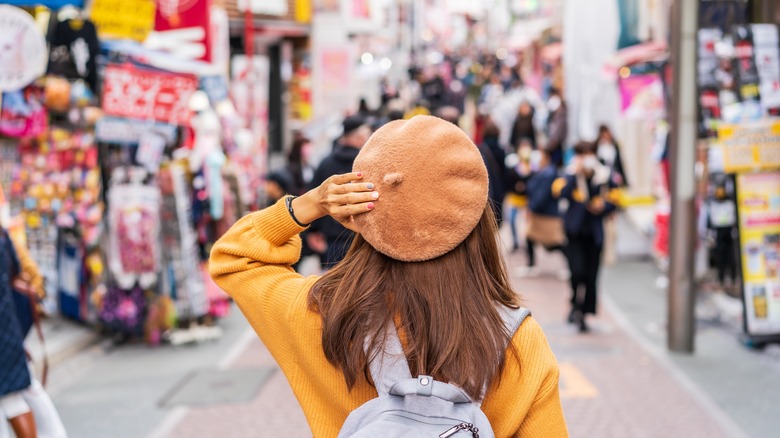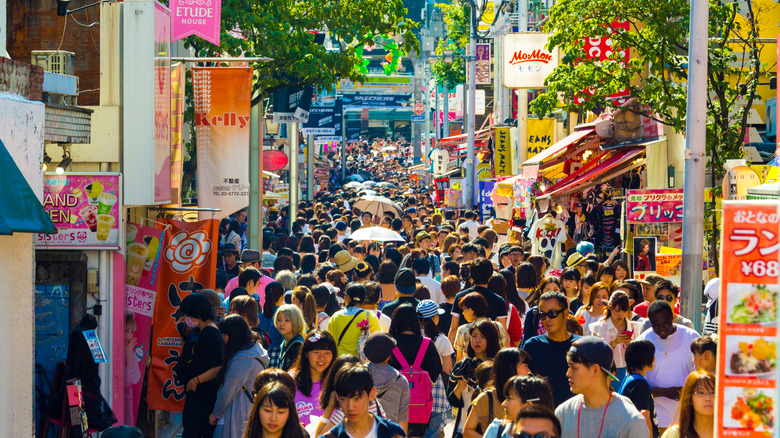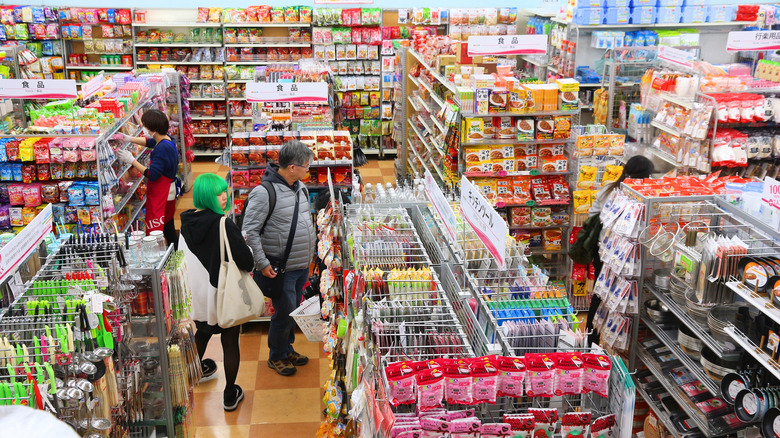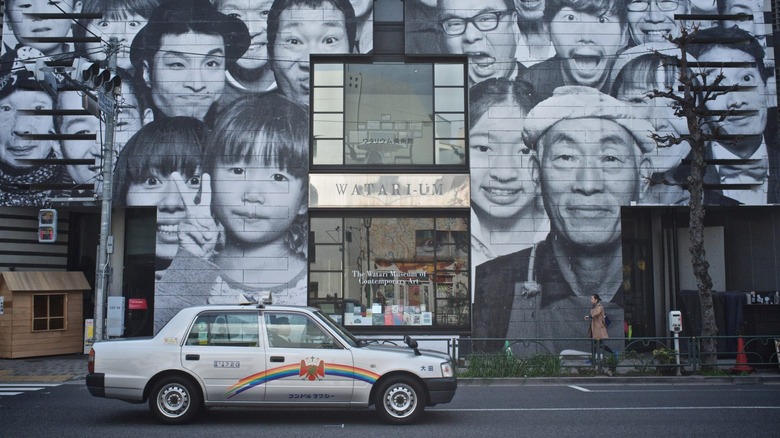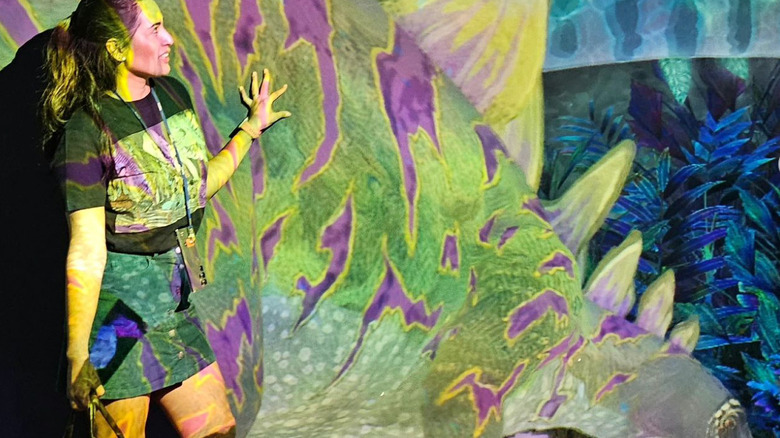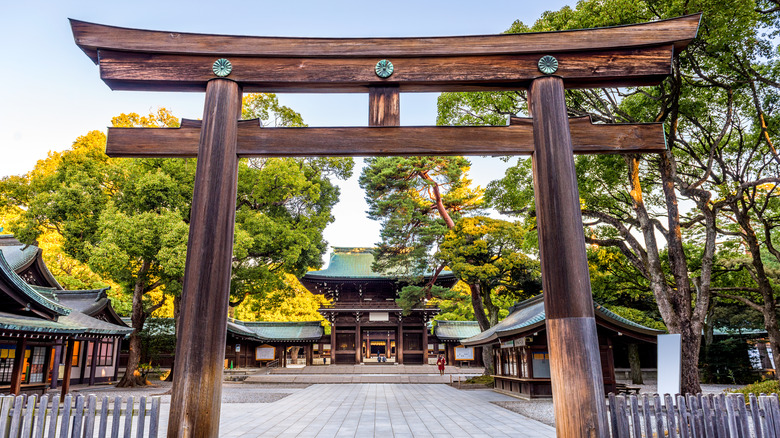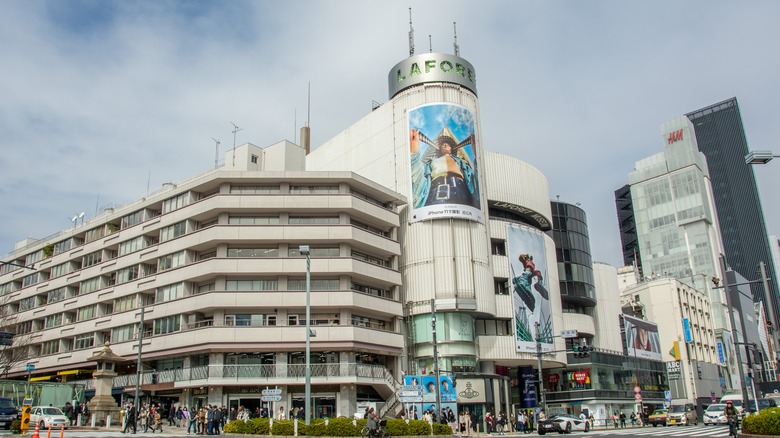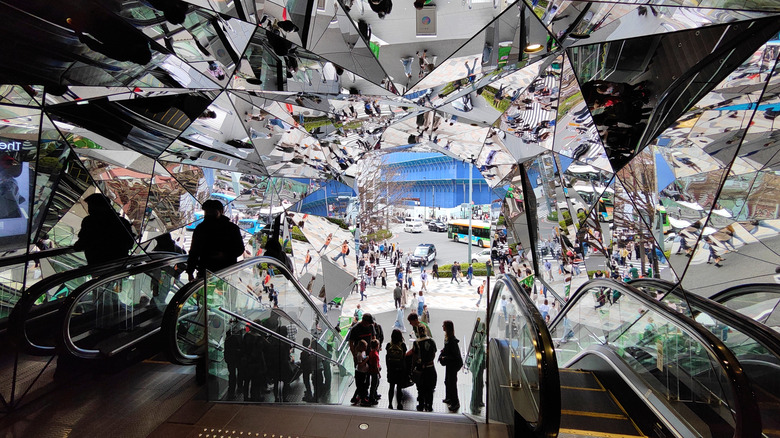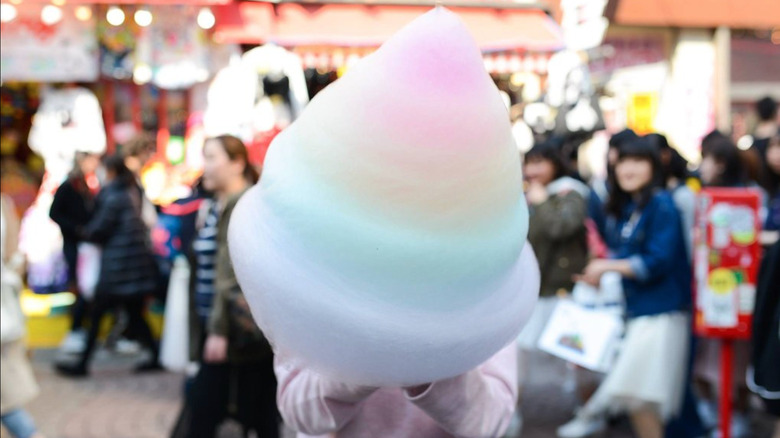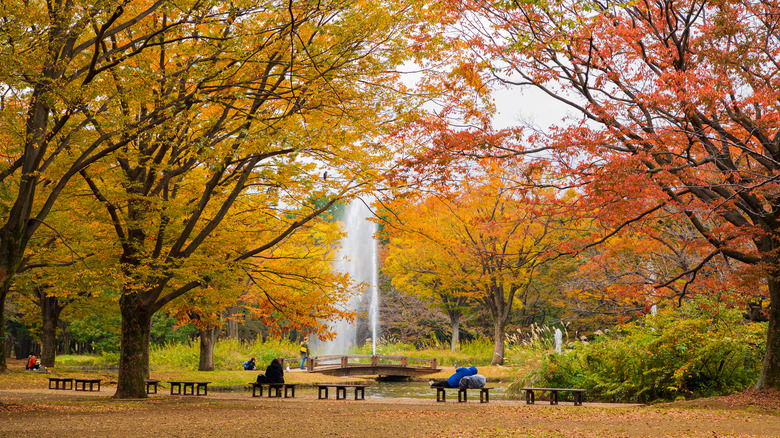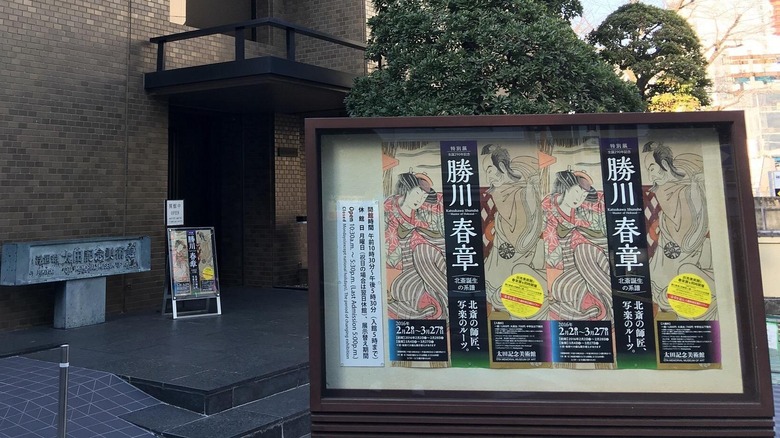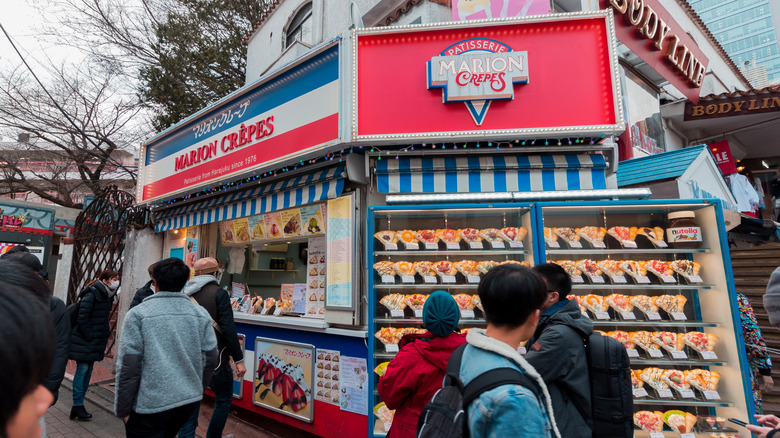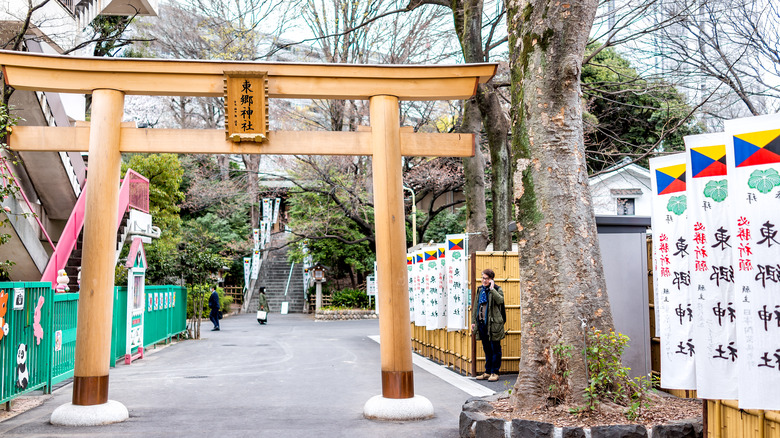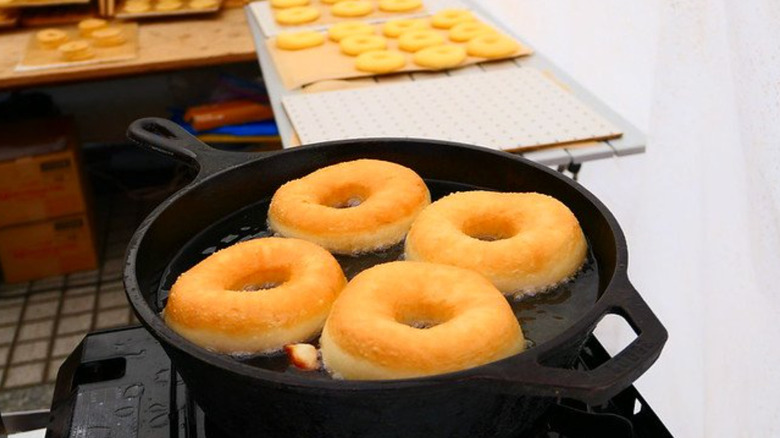13 Must-Do Things In Tokyo's Harajuku District
Located in the Shibuya ward of Tokyo, west of downtown, Harajuku is one of the most famous neighborhoods in Japan. All things quirky, cute, and colorful thrive in this tangled web of streets. Kawaii and Lolita fashion were born on the streets of Harajuku, but pull back the frenzied whirlwind of costumes, performative arts, and glitzy shopping centers, and there's so much more to Harajuku than meets the eye. While fashion certainly reigns supreme here, look just off the frenzied streets of Takeshita Dori and there are plenty of peaceful reprieves from the madness.
Yoyogi Park is one of the largest in all of Tokyo and two stunning shrines also call Harajuku home. Art museums, both contemporary and traditional, are tucked within the jumble of buildings. And it's no wonder with so much inspiration around every corner. With so much to do in such a small wedge of the city, it can be easy to miss some of the best things. Whether you're a fan of art, fashion, and bustling streets or calm green spaces to explore historic sites, the Harajuku District is home to plenty of Tokyo's must-do things.
Takeshita Dori
The birthplace of kawaii fashion, Takeshita Dori is the beating heart of Harajuku and the place to be if you're interested in Harajuku's quirky side. Takeshita Dori essentially translates to Takeshita Street. Walk down this chaotic road and you're bound to see the very best of Harajuku fashion and performance. Founded in the 1990s, Harajuku was born from knock-off clothing brands, both American and Japanese. This was the zenith of secondhand stores and vintage fashion in Tokyo at its finest.
Iconic shops line each side of Takeshita Dori's 1300-foot road. Some of the most notable are Chicago, Etude House, and Panama Boy. While the mega shopping centers of Laforet and the Tokyu Plaza aren't far away, Takeshita Dori focuses more on secondhand stores alongside the Kawaii-dedicated shops. If you've made the trek to Takeshita Dori to see the whacky, wonderful, and weird exposés, your best bet is on the weekends. Commemorate your trip with a visit to one of the street's many purikura, or photo booths, preferably dressed in your best Kawaii fashion.
Daiso 100 Yen
Similar to American stores like Dollar Tree or Below Zero, only much more quirky and cute, Daiso 100 Yen is a novelty shop where everything costs about — you guessed it — 100 yen. From stickers to snacks and candy, you can spend a shocking amount of money and time here. One hundred yen equals out to about $.65, but it can add up quickly when there are over 70,000 different items to sift through!
Some of the notoriously great things to seek out are their stationary and sushi-shaped erasers, but the souvenir items are where Daiso really stands out. Japan-specific items you should put on your list are cute bento boxes, sake cups, washi tape, origami paper, Manekineko Tabi socks, and all things Hello Kitty. There are also Japanese food products like matcha and seaweed snacks, as well as a slew of unusual but useful electronics like battery-operated lint rollers. If you can dream it up, chances are you can find it at Daiso. Visitors also rave about their beauty products, so make your list and get to shopping before your trip to Harajuku.
The Watari-Um Museum of Contemporary Art
Watari-Um Museum of Contemporary Art is a popular art museum located in the middle of Harajuku. The museum showcases a rotating cast of exhibits throughout the year and has featured pieces from internationally famous artists like Andy Warhol, as well as celebrated Japanese artists such as Yayoi Kusama. Many also consider the concrete-poured building itself as a contemporary masterpiece. Designed by Swiss architect Mario Botta, the geometric architecture is reminiscent of Botta's other designs, such as the San Francisco Museum of Modern Art and Casino di Campione in Italy.
Admission varies depending on the exhibition, and hours are from 11 a.m. to 7 p.m. The museum is closed on Mondays. Don't forget to stop by the bookstore and café for one last moment of tranquility before you head back into the streets of Harajuku. However, if your contemporary art appetite isn't satiated, you can also explore the nearby Nanzuka Underground.
Galaxy Harajuku
A collaboration between phone giant Galaxy and teamLabs, Galaxy Harajuku transports visitors to a different world through light, color, and sound. The current exhibit, Catching and Collecting in the Dinosaur Forest, is a psychedelic display of prehistoric animals come to life. Guests can use their Galaxy Smartphone to capture the dinosaurs, much like a Pokémon, and build a virtual collection book. If you're an Apple user, you can still experience the exhibit, although you won't be able to virtually wrangle any neon dinosaurs.
New exhibits are put on display each year, so if you've already been, it's worth it to see if the latest exhibit has changed. Guests can also take part in other interesting experiences inside the Galaxy building. If you're a Galaxy Phone fanatic, head to the second floor to create your own accessories. The sixth floor, the Galaxy Purple Floor, is designed for taking selfies with unique backgrounds. Admission to Galaxy Harajuku is completely free, and you can reserve a place in line ahead of time through their website.
Meiji Shrine
Dedicated to Emperor Meiji and Empress Shoken, the massive Meiji Shrine is both a powerful and delicate site to behold. The imposing tori gate, colorful barrels of sake, and iris garden make for beautiful photo opportunities, but you'll need to remember that this is a religious site. The Meiji Shrine is a Shinto shrine, and it's important to practice etiquette while inside the temple grounds. To ensure you're being a considerate tourist in Japan, the shrine's official website details this etiquette and the proper ways of purification. A few things to keep in mind are that you cannot take pictures inside the main sanctuary and there is no eating, drinking, or smoking.
The shrine is located just next to the sprawling Yoyogi Park. Pop into the Meiji Jingu Museum to see artifacts pulled straight from the shrine itself, giving greater historical meaning to visitors. Festivals are held at the shrines throughout the year, including the Autumn Grand Festival. It's completely free to visit the Meiji Shrine. Opening and closing hours vary, depending on the month of the year, though it's open longer during the summer months. If you're interested in a free walking tour of not only the Meiji Shrine but also the surrounding area, consider signing up with Tokyo Localized.
Laforet
If Harajuku is the birthplace of Kawaii fashion, Laforet is the mothership. The central nucleus of Harajuku's fashion scene, Laforet has been supplying the goods in terms of colorful clothing since 1978. Sift through its many shops and stores to find outfits and accessories that will help you blend in with the crowd outside. Shopping here spans from serious luxury like Louis Vuitton to bargain accessory stores. You'll also see many shops solely dedicated to Kawaii fashion, such as Alice and the Pirates, Heihei, and Majoh.
Laforet is also home to several restaurants and cafés, including a Mexican restaurant, and hours are from 11 a.m. to 8 p.m. Getting to Laforet is incredibly easy, as the Meiji Jingumae Station is just outside the doors. There are a few rules to keep in mind while shopping. You can't take any pictures of the shops without permission, and no eating or drinking is allowed anywhere outside the cafés. As a bonus tip, if you want to partake in some of the tax-free shopping, bring your passport.
Tokyu Plaza Omotesando Harajuku
From the outside, Tokyu Plaza might seem like just another shopping center, and you wouldn't be wrong. But the true star of the show is the ceiling of mirrors at its entrance. Many people clamor for the perfect photo op after they're finished searching for the latest Kawaii fashions. Tokyu Plaza is home to many American stores like Starbucks, American Eagle, and Tommy Hilfiger, while also offering its fair share of Japanese name brands. Head up to the rooftop for a secret garden and views over the madness of Harajuku's busy streets.
This also happens to be a great place to grab a bite to eat in Harajuku. Pick from classic Japanese fare like Salon Oeuf et Moi, dishing up the perfect Japanese omelets, or Yakitori Arakiyama, serving delicious BBQ meats. The club and restaurant combo, Ce La Vi is also housed inside Tokyu Plaza and features a Sky Bar. Tokyu Plaza is open from 11 a.m. to 8 p.m., every day of the week.
Totti Candy Factory
Practically an institution in Harajuku, the Totti Candy Factory is the original spot for cotton candy. You'll see these towering, rainbow wisps floating around the streets of Harajuku. While you can get cotton candy from various spots around town, this is the place for rainbow wata-kashi, which is Japanese for cotton candy. Each color has a different flavor. The rainbow cotton candy with nine colors costs just $6 (900 yen), while the three-color version is only $4 (600 yen).
Aside from this light-as-air confectionary delight, the Totti Candy Factory sells candy from all over the world. This vast list also includes homemade treats like cake pops shaped like kawaii animals. Once you've secured your colorful confection, take to the streets of Harajuku for the perfect photo op. Keep in mind that it's considered rude to eat while walking around in Japan. Most patrons of Totti Candy Factory snap their pictures just outside and then eat the cotton candy in front of the nearby FamilyMart.
Yoyogi Park
With 133 acres to explore, Yoyogi Park is a substantial green space in Tokyo that's great for getting a breath of fresh air and a break from the chaotic streets of Harajuku. The Olympic Village and several other buildings were built inside of Yoyogi Park in preparation for the 1964 Olympics. Visitors can rent bikes to explore the park, admire the idyllic fountains, or bring a picnic. Like the rest of the Harajuku area, performers dress up and dance on weekends in Yoyogi Park.
For fall foliage views in Japan, Yoyogi Park is particularly well-known for its vibrant yellow ginkgo forest in autumn. It's also a great spot to experience hanami, or cherry blossom viewing, in spring. There's no fee to use the park and it's open 24/7, although the facilities are only open from 9 a.m. to 5 p.m. This is the perfect stop before or after a visit to the Meiji Shrine, which is located within the park itself, and it's only a few minutes walk to reach the park from nearby Harajuku Station.
Ota Memorial Museum of Art
The Ota Memorial Museum of Art showcases beautiful ukiyo-e, or woodblock prints, from famous Japanese artists like Hiroshige. The museum is home to a vast collection, 12,000 strong, that was gathered by Ota Seizo V, the late president of Tōhō Insurance Company. He recognized the need to preserve Japan's traditional art, which seemed to be popping up in museums around the world but not adequately celebrated on its native soil. If you like the famous woodblock print, "The Wave," you'll love this museum.
Admission prices vary, depending on the showcased exhibits, but you'll typically only spend between $4 to $5.50 (600 and 800 yen). Hours are from 10:30 a.m. to 5:30 p.m., but the last admission is at 5 p.m. Although the museum doesn't display any permanent exhibits, it does show a movie based on its origins on Sundays from 11 a.m. to 2 p.m. No photography is allowed.
Marion Crêpes
While it may sound a little strange, crêpes are something of a food staple in Harajuku, and Marion Crêpes started it all. Much like the crêpes served in France, foodies will find both sweet and savory fillings like whipped cream, cheesecake, and even tuna. Stop by the original store in the heart of Harajuku for the perfect snack to fuel your shopping adventures. Marion Crêpes began as a humble food truck in 1976 but has expanded to over 80 locations across Japan.
Falling in line with the many French-inspired shops with their cutesy fashion sense, the crêpes are wrapped in a pretty, red checkered paper, which tends to encourage obligatory food selfies. The main flagship store in Harajuku is open 10:30 a.m. to 8 p.m., Monday through Friday, and 10 a.m. to 8 p.m. on weekends. The crêpes range between $3.56 (540 yen) to $5.15 (780 yen) in price, depending on filling.
Togo Shrine
Built to commemorate the infamous General Heihachiro Togo, the Togo Shrine is a peaceful reprieve from the bustling streets of Tokyo. The park is dedicated to the war hero, honoring General Togo for his victory over the Russian army during the Russo-Japanese War. Stroll beneath the shrine's pretty tori gate, along the koi ponds, and amid the idyllic gardens. Many residents of the city come to this particular shrine before a competition due to its association with the general's victory.
Incredible events take place at the Togo Shrine throughout the year, including the Togo Katsu Sumo match. Every year, even babies between the ages of 6 months and 3 years participate. Traditional Shinto weddings are also frequently held in the shrine's sprawling gardens. You may notice a distinctive black, red, yellow, and blue flag around the shrine. This was the very flag that the general raised as he went into battle against the Russians. Admission is free, and a complimentary bus even picks up and drops off prospective visitors from Harajuku Station. The shrine is open from 6 a.m. to 5 p.m.
Higuma Donuts
Still craving sweets? Follow the intoxicating smell of freshly fried bread straight to Higuma Doughnuts. While not one of Tokyo's famous cat cafes, Higuma still enjoys a cult-like following in Harajuku. Their doughnuts were born from the pure ingredients of Hokkaido in Japan's far north and feature flavors like honey mascarpone, kinako, and even a donut burger. Without the use of preservatives or additives, seasonal flavors make doughnut options even more fun for patrons.
Higuma Doughnuts' space in Harajuku is conveniently shared with Coffee Wrights who make delicious lattes, the perfect compliment to the sugary doughnuts. Coffee Wrights' beans come from across the world, from Rwanda to Colombia, and they offer single-origin coffee beans and steeping bags to take home. The café boasts a beautifully contemporary yet cozy design, making it the perfect place to unwind while exploring the Harajuku area. The café is open from 11 a.m. to 6 p.m. daily, but they're closed on Wednesdays.
